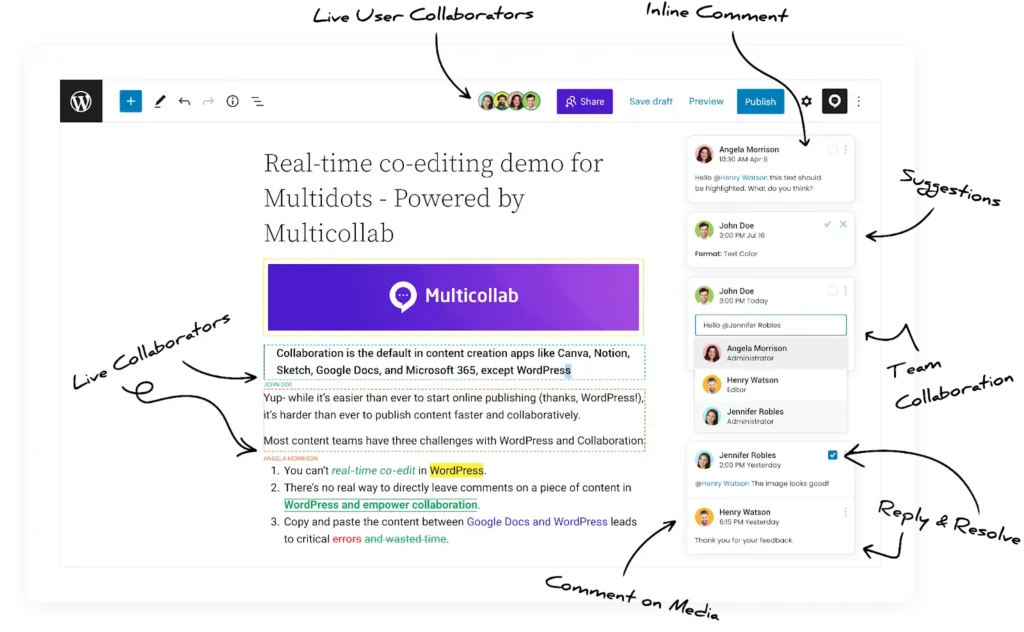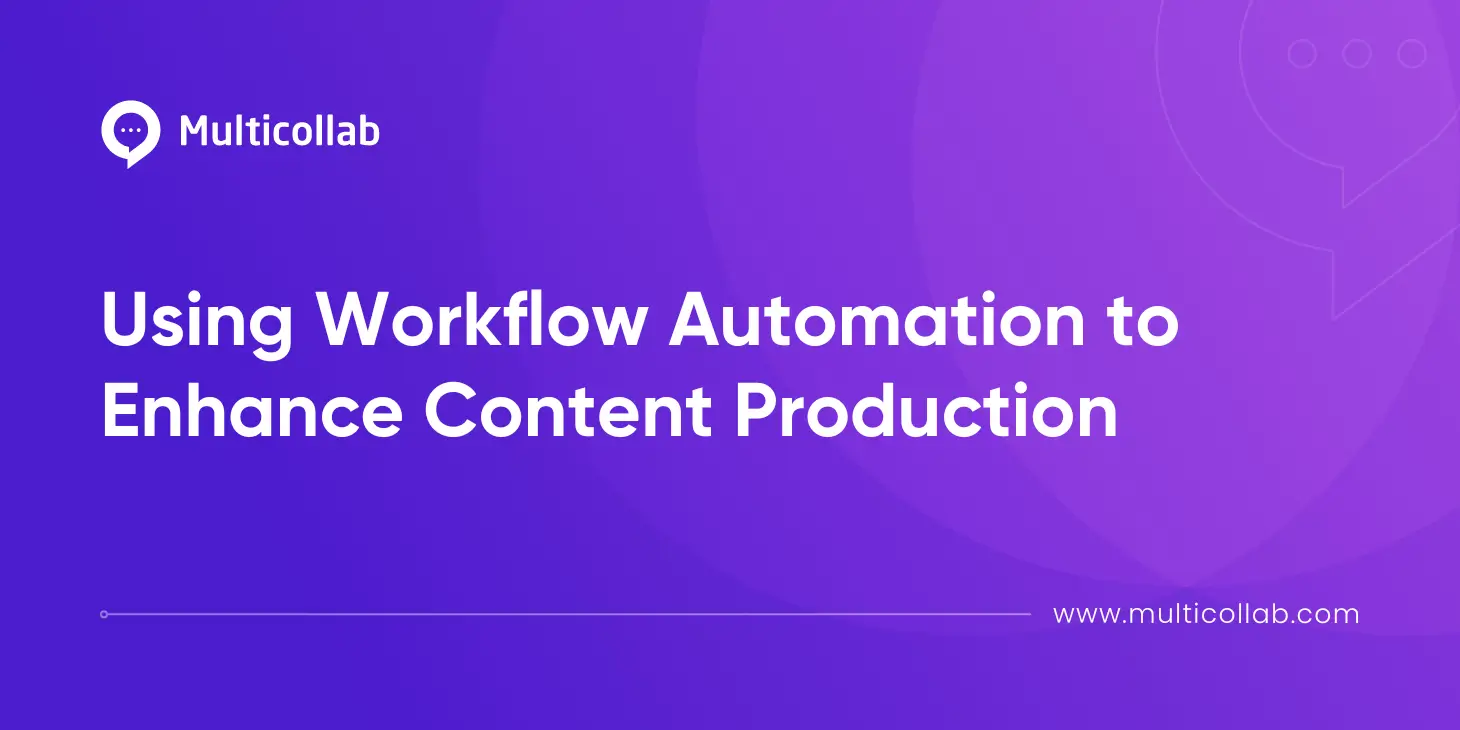Table of Contents
Do you know about the usual bottlenecks in an inefficient workflow? Missed deadlines, scattered feedback, endless email threads – ring a bell? It’s a common struggle for many content teams. In fact, only 21% of organizations report having truly efficient content and creative workflows. For most, these bottlenecks don’t just slow down progress – they lead to missed opportunities that could have been avoided with a better process in place.
But what if you could eliminate these hurdles altogether? With the right editorial workflow tools – featuring real-time editing, seamless integrations, and advanced feedback systems – your team can streamline collaboration and significantly boost productivity.
In this article, we’ll dive into the best solutions available, including Multicollab, a WordPress-native plugin that enhances collaboration directly within your CMS. Whether you’re aiming to accelerate the draft-to-publish process or improve communication across your team, these tools can transform your content workflows and set your team up for lasting success.
Streamlining editorial workflows: The key to content success
An editorial workflow isn’t just a checklist –it’s a structured process that guides the whole content journey, from creation and editing to approval and publication. Each stage comes with clear roles and responsibilities, so everyone, from writers to editors to project managers, knows exactly what’s expected of them.
A smooth editorial workflow is critical for keeping content quality high, ensuring consistency, and maintaining team productivity. WordPress-based editorial teams, in particular, juggle managing content across platforms and it’s easy to feel overwhelmed.
Managing increasing content demands: Editorial teams often struggle to keep up with creating and publishing content across blogs, social media, and custom post types, especially when handling and managing large volumes.
Coordinating remote team members: With distributed teams working across time zones, misalignment on tasks or synchronizing drafts can lead to delays and miscommunication.
Tracking revisions and feedback: Working within WordPress can be cumbersome when managing multiple rounds of feedback, causing confusion as editors switch between different versions or lose track of inline comments made through external tools.
Maintaining content quality under deadlines: When WordPress teams are rushed to meet publishing deadlines, they may overlook important SEO optimizations, miss broken links, or skip proofreading, which negatively impacts content quality.
Overcoming inefficiencies in processes and tools: Without proper workflow plugins or integrations, teams might waste time manually scheduling posts, updating metadata, or navigating multiple third-party tools, all of which can hinder overall productivity.
These challenges often lead to missed deadlines, inconsistent content quality, and frustrated teams. By implementing a structured editorial workflow and leveraging advanced tools, teams can streamline their processes significantly. These tools not only enhance content quality but also significantly reduce draft-to-publish time, keeping the entire editorial process running smoothly. And this is how you can help your content team meet their goals with less stress.
The best editorial workflow tools to revolutionize content production
Now that we’ve established how crucial the right editorial workflow tools are for creating and publishing top-tier content, it’s clear they can streamline every stage of the process – from idea planning and content production to collaboration, approval, and distribution. Let’s dive into some of the top tools available to transform your editorial workflows and give your team the competitive edge.
Project management
The first stage of an efficient editorial workflow is all about planning, task management, and organization. Managing multiple projects, assigning tasks, and tracking deadlines can be overwhelming without the right tools. That’s where project management platforms come in, providing structured workflows that keep everyone on the same page.
For instance, Asana’s timeline feature allows teams to manage complex, interdependent projects seamlessly, integrating well with various content management systems. Trello enhances efficiency through automation, streamlining repetitive tasks that can bog down the editorial process. Meanwhile, Monday.com offers custom workflow templates tailored for editorial teams, alongside robust data visualization capabilities for tracking content performance. CoSchedule stands out as a marketing calendar and workflow management tool specifically designed for content creators and marketers.
By utilizing these tools, editorial teams can better manage their content production pipelines, enhance efficiency, and ensure high-quality content is consistently delivered on time.
Content production
Once the planning is in place, the next stage is content creation where writers dive into the process of drafting, researching, and writing. This is also where AI-powered tools can help make the writing process smoother and more efficient.
For example, Copy.ai can whip up detailed content briefs and outlines based on complex strategies, saving writers a ton of time. Anyword offers predictive performance scores, helping you optimize content for various platforms even before it’s published. Then there’s Claude, which assists with in-depth research and lets you compare multiple documents with ease. Lex offers a distraction-free writing environment, complete with smart editing suggestions that help refine your ideas.
While it is good to have the assistance of these tools to speed things up and improve quality, don’t forget to keep a human touch. After all, maintaining your brand voice and ensuring everything is factually accurate is what truly connects you to your audience.
Content collaboration
This is the editing and review stage where the focus shifts to refining the draft. Editors meticulously check for grammar, structure, tone, and accuracy, wanting to ensure that everything aligns with brand guidelines. Tools like Grammarly and Hemingway Editor come in handy here, providing instant feedback and helping maintain a polished voice.
Once the editing is complete, the content is sent for approval, whether that’s within the team or to a client. This stage often involves multiple rounds of revisions, requiring effective collaboration among various contributors. Here’s where tools like Google Docs usually come in, but for WordPress users, Multicollab takes collaboration to the next level.
Multicollab can streamline editorial workflows within the WordPress environment, offering a native solution. Its real-time collaboration, inline commenting, and suggestion mode – significantly cut down on time-to-publish, making it easier to get feedback quickly. The @mentions feature and comment assignment functionality ensure that tasks are managed efficiently, keeping everyone on track.
For larger teams, Multicollab’s Slack and email notifications help maintain synchronization, while custom permissions and guest collaboration features allow for effective management of complex editorial hierarchies. Plus, its a top recommendation for remote content teams, ensuring that their approval processes is seamless and that quality content is published without unnecessary delays.
Video and photography
We know that quality content is well complemented with high-quality video and photos. Hence, managing these assets effectively is essential. For teams that rely heavily on visual content, managing video and photography workflows can be especially challenging. From planning to editing and distributing visual assets, specialized tools are key to staying organized.
For instance, Iconik’s AI-powered tagging and transcription features allow teams to efficiently manage large media libraries and even find assets quickly. It is cloud-native, hence it allows remote collaboration, ensuring that everyone can access and work on visual content regardless of location.
Similarly, Creative Force offers an end-to-end production workflow management system that automates repetitive tasks in photo and video production. This not only saves time but also minimizes the potential for errors.
Both Iconik and Creative Force tackle common challenges associated with managing large volumes of visual content. By providing centralized access, improving collaboration, and simplifying approvals, these tools empower teams to produce stunning video and photography content efficiently.
Publishing, distribution, and marketing
Once your content is approved, the next step is to publish it on the right platforms, such as your website or blog. After publishing, you distribute and promote it through various avenues, such as newsletters, social media posts, and paid advertising. This multi-channel approach ensures that your content reaches the widest possible audience.
Tools like StoryChief offer omnichannel publishing capabilities, allowing you to seamlessly distribute your content across various platforms while optimizing it for search engines. This means your content not only reaches your audience but is also more likely to be discovered.
For social media, Buffer’s AI-assisted scheduling helps you time your posts perfectly, maximizing visibility and engagement on each platform. It takes the guesswork out of posting, ensuring your content hits feeds when your audience is most active.
Hootsuite is another powerhouse, providing social listening tools that help you gauge audience sentiment and inform your content strategy. Its team collaboration features make managing large-scale social media operations much easier.
After publishing, you can monitor performance metrics like views, engagement, and conversions with tools like Google Analytics, SEMrush, and Ahrefs. This data is essential for refining future content strategies and ensuring your efforts yield the best results.
Multicollab: Transforming WordPress collaboration for content teams
Multicollab is changing the game for content teams using WordPress, bringing the power of real-time collaboration right into your editing environment. Imagine working on your article with team members simultaneously, just like in Google Docs – no more frustrating app-switching or lost feedback!

Real-time editing and commenting: With Multicollab, real-time editing means you can see changes and comments as they happen. Inline comments allow for quick clarifications right in the text, making feedback a breeze. This streamlined process can significantly reduce your draft-to-publish time. When you’re not juggling between Google Docs, emails, and WordPress, you save precious minutes –no more copying and formatting issues that slow you down.
Version control and feedback management: One of the standout features is Multicollab’s version control. You can easily view previous versions and use the suggestion mode to propose edits without changing the original text. This keeps all feedback centralized in WordPress, eliminating the chaos of scattered email threads and external documents.
Streamlined approvals and notifications: The role-based custom permissions feature ensures that everyone knows their responsibilities, while @mentions and comment assignments make task distribution clear and manageable. Integrations with Slack and email keep teams updated, seamlessly fitting into existing workflows and minimizing disruptions.
Adaptability to teams of all sizes: Multicollab is designed to scale, catering to everyone from small teams to large enterprises. Its guest collaboration feature allows external contributors to join the workflow without needing full WordPress accounts, making it easy to include freelancers or clients in the process.
What truly sets Multicollab apart is its ability to keep collaboration within the familiar WordPress environment. This means your team can hit the ground running, as there’s no steep learning curve. From the first draft to publication, Multicollab ensures a smooth workflow, allowing you to focus on creating high-quality content without getting lost in complicated processes.
Elevate your content collaboration: Start your Multicollab journey today
Choosing the right editorial workflow tools is crucial for content teams looking to succeed. It’s important to align tools with your team’s specific needs and pain points, prioritize solutions that integrate seamlessly with your existing systems, and consider budget and scalability for future growth.
Editorial workflow tools like Multicollab can significantly enhance WordPress content creation. Its many benefits include streamlined collaboration, time savings, improved team productivity, and higher content quality. Trusted by content and marketing teams at leading publishers, news organizations, and media enterprises such as Gannett, The San Francisco Standard, SmartAsset.com, and more, Multicollab continues to elevate content workflows.
So, why wait? Explore how Multicollab can elevate your content workflow and supercharge your editorial process in WordPress today!







